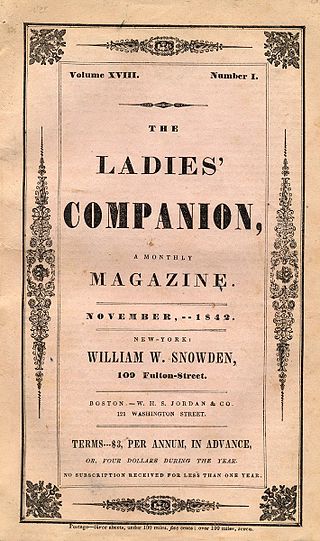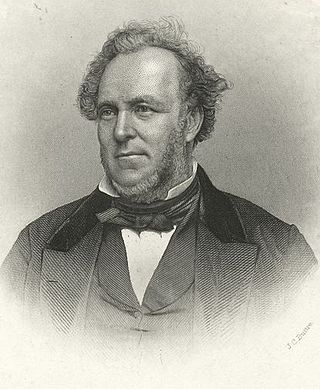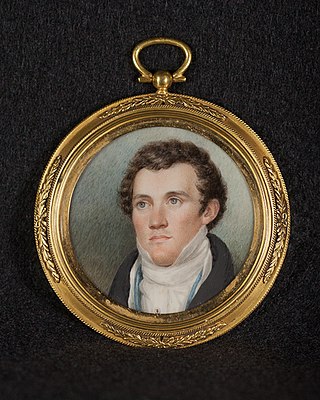
The Poets and Poetry of America was a popular anthology of American poetry collected by American literary critic and editor Rufus Wilmot Griswold. It was first published in 1842 and went into several editions throughout the 19th century.

The Poets and Poetry of America was a popular anthology of American poetry collected by American literary critic and editor Rufus Wilmot Griswold. It was first published in 1842 and went into several editions throughout the 19th century.
Rufus Griswold had begun work as a critic working for the New York Tribune [1] and Philadelphia's Daily Standard and earned his reputation as a vindictive and savage literary critic. [2] He was also a proponent of American poetry. He claimed to have read every American poem published before 1850—an estimated 500 volumes. [3] His nationalism was well known. Publisher Evert Augustus Duyckinck noted that "the thought [of a national literature] seems to have entered and taken possession of [Griswold's] mind with the force of monomania". [4] His anthology was part of his ongoing efforts to promote distinctly American poetry.

Philadelphia publishers Carey & Hart wrote to Griswold in New York on April 18, 1842, "We have at last published the 'Poets & Poetry of America' & a handsome Book it is". [5] The anthology was 476 pages [1] and collected poems from over 80 authors, [6] including 17 by Lydia Sigourney, three by Edgar Allan Poe, and 45 by Charles Fenno Hoffman. [2] It gave prominent space to some of the most popular poets of the day, including Henry Wadsworth Longfellow and William Cullen Bryant. [1] The collection was dedicated to Washington Allston. [7]
The book proved popular enough that it went through three editions within only six months. [1] A minor poet from Virginia named Daniel Bryan wrote of his disbelief at the rapidity with which the book went into new editions. "Is there not some of the 'trickery of trade' in this?—What was the am[ount] of the 1st edition—and may not the 2nd ed. have been printed at the same time the 1st was?" [8] After Griswold's death, Richard Henry Stoddard revised the book and issued several new editions later in the 19th century. [9]

The Poets and Poetry of America was the most comprehensive of its kind up to that period. [1] After its release, it was called "the most valuable publication of the season" in the April 23, 1842, issue of the Saturday Evening Post . [10] Critic Lewis Gaylord Clark considered it important to "become incorporated into the permanent undying literature of our age and nation". [11]
Some critics, however, did not agree with Griswold's selections. The Albany, New York-based Poet's Magazine criticized the "undue prominence" granted to lesser poetasters, including Edgar Poe. [12] Charles Fenno Hoffman, for example, was a friend of Griswold and, despite having little literary reputation, was granted twice as much space as any other poet. [13] Responding to the idea that The Poets and Poetry of America represented the best that the United States had to offer, one British editor concluded, "with two or three exceptions, there is not a poet of mark in the whole Union". [14] Modern scholars have dismissed the anthology as a "graveyard of poets" because many of the writers collected are now virtually unknown. [9] Literary historian Fred Lewis Pattee called the book a "collection of poetic trash" and "voluminous worthlessness". [15]
In his day, The Poets and Poetry of America propelled Griswold to a national spotlight in the 1840s and 1850s. [2] His success led to future anthologies, including Gems from American Female Poets (1842), [16] The Poets and Poetry of England in the Nineteenth Century (1844), [17] The Poets and Poetry of England (1845), Prose Writers of America (1847), and The Female Poets of America (1848). [18]

Alice Cary was an American poet, and the older sister of fellow poet Phoebe Cary (1824–1871).

Frances Sargent Osgood was an American poet and one of the most popular women writers during her time. Nicknamed "Fanny", she was also famous for her exchange of romantic poems with Edgar Allan Poe.

Charles Fenno Hoffman was an American author, poet and editor associated with the Knickerbocker Group in New York.

Rufus Wilmot Griswold was an American anthologist, editor, poet, and critic. Born in Vermont, Griswold left home when he was 15 years old. He worked as a journalist, editor, and critic in Philadelphia, New York City, and elsewhere. He built a strong literary reputation, in part due to his 1842 collection The Poets and Poetry of America. This anthology, the most comprehensive of its time, included what he deemed the best examples of American poetry. He produced revised versions and similar anthologies for the remainder of his life, although many of the poets he promoted have since faded into obscurity. Many writers hoped to have their work included in one of these editions, although they commented harshly on Griswold's abrasive character. Griswold was married three times: his first wife died young, his second marriage ended in a public and controversial divorce, and his third wife left him after the previous divorce was almost repealed.

Nathaniel Parker Willis, also known as N. P. Willis, was an American author, poet and editor who worked with several notable American writers including Edgar Allan Poe and Henry Wadsworth Longfellow. He became the highest-paid magazine writer of his day. His brother was the composer Richard Storrs Willis and his sister Sara wrote under the name Fanny Fern. Harriet Jacobs wrote her autobiography while being employed as his children's nurse.

"The Mystery of Marie Rogêt", often subtitled A Sequel to "The Murders in the Rue Morgue", is a short story by American writer Edgar Allan Poe written in 1842. This is the first murder mystery based on the details of a real crime. It first appeared in Snowden's Ladies' Companion in three installments, November and December 1842 and February 1843. Poe referred to it as one of his "tales of ratiocination".
Nationality words link to articles with information on the nation's poetry or literature.

Sarah Helen Power Whitman was an American poet, essayist, transcendentalist, spiritualist and a romantic interest of Edgar Allan Poe.

Park Benjamin Sr. was well known in his time as an American poet, journalist, editor and founder of several newspapers.

Graham's Magazine was a nineteenth-century periodical based in Philadelphia established by George Rex Graham and published from 1840 to 1858. It was alternatively referred to as Graham's Lady's and Gentleman's Magazine, Graham's Magazine of Literature and Art, Graham's American Monthly Magazine of Literature and Art, and Graham's Illustrated Magazine of Literature, Romance, Art, and Fashion.

George Rex Graham was an American magazine editor and publisher from Philadelphia, Pennsylvania. He founded the journal Graham's Magazine at the age of 27 after buying Burton's Gentleman's Magazine and Atkinson's Casket. His journal became very popular and it was known for its generous payment to contributors.
The Broadway Journal was a short-lived New York City-based newspaper founded by Charles Frederick Briggs and John Bisco in 1844 and was published from January 1845 to January 1846. In its first year, the publication was bought by Edgar Allan Poe, becoming the only periodical he ever owned, though it failed after only a few months under his leadership.
"The Haunted Palace" is a poem by Edgar Allan Poe. The 48-line poem was first released in the April 1839 issue of Nathan Brooks' American Museum magazine. It was eventually incorporated into "The Fall of the House of Usher" as a song written by Roderick Usher.

Cornelius Mathews was an American writer, best known for his crucial role in the formation of a literary group known as Young America in the late 1830s, with editor Evert Duyckinck and author William Gilmore Simms.

Tamerlane and Other Poems is the first published work by American writer Edgar Allan Poe. The short collection of poems was first published in 1827. Today, it is believed only 12 copies of the collection still exist.

Elizabeth Fries Ellet was an American writer, historian and poet. She was the first writer to record the lives of women who contributed to the American Revolutionary War.

Thomas Holley Chivers was an American doctor-turned-poet from the state of Georgia. He is best known for his friendship with Edgar Allan Poe and his controversial defense of the poet after his death.

Thomas Dunn English was an American Democratic Party politician from New Jersey who represented the state's 6th congressional district in the House of Representatives from 1891 to 1895. He was also a published author and songwriter, who had a bitter feud with Edgar Allan Poe. Along with Waitman T. Barbe and Danske Dandridge, English was considered a major West Virginia poet of the mid 19th century.
The Opal: A Pure Gift for the Holy Days, was an annual gift book, founded by Rufus Wilmot Griswold and published in New York by John C. Riker, from 1844 to 1849. Content included short stories, illustrations and poems.

Grenville Mellen was an American poet and lawyer, and the eldest son of Supreme Court Chief-Justice Prentiss Mellen.